The arts are integral to our daily lives and culture. We’re surrounded by colors and designs, listen to music on the radio, and tap our feet or move to the rhythms we hear. The meanings communicated in different art forms, such as music, dance, paintings, written language, or sculpture, are unique. The meanings expressed in a piece of music, for example, do not have equivalent meanings in drama and the meanings expressed in dance cannot be duplicated in the same way in a painting. Sometimes, though, the importance and relevance of the arts are minimized and not appreciated. In this week’s book review column, members of the International Reading Association's Children’s Literature and Reading Special Interest Group highlight the role the arts play in our lives and also hope to spark the imagination of readers to consider and try other varied ways to share meaning.
For classroom ideas see ReadWriteThink.org's lesson ideas featuring the arts.
GRADES K-3
Daywalt, Drew. (2013). The day the crayons quit. Illus. by Oliver Jeffers. New York: Philomel Books.
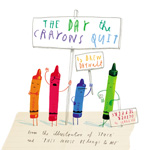 When Duncan goes to take his box of crayons out of his desk, he finds a stack of letters with his name on them. The twelve letters were written by his crayons, each detailing a complaint or demand. Red, for example, feels it works too hard, especially on holidays. Purple likes to be neat and wants Duncan to color in the lines. Beige is proud of itself and doesn’t like being second place to Brown. Gray is tired of coloring big animals. And Yellow and Orange are involved in a dispute over the color of the sun. Duncan finds a creative way to color and make his crayons happy at the same time. Jeffers’s colorful and playful drawings make the personalities of the crayons come to life. This is a fun book about color that is sure to spark the imagination of young readers.
When Duncan goes to take his box of crayons out of his desk, he finds a stack of letters with his name on them. The twelve letters were written by his crayons, each detailing a complaint or demand. Red, for example, feels it works too hard, especially on holidays. Purple likes to be neat and wants Duncan to color in the lines. Beige is proud of itself and doesn’t like being second place to Brown. Gray is tired of coloring big animals. And Yellow and Orange are involved in a dispute over the color of the sun. Duncan finds a creative way to color and make his crayons happy at the same time. Jeffers’s colorful and playful drawings make the personalities of the crayons come to life. This is a fun book about color that is sure to spark the imagination of young readers.
- Prisca Martens, Towson University, Towson, Maryland
Kulling, Monica. (2013). Lumpito and the painter from Spain. Illus. by Dean Griffiths. Toronto, Ontario: Pajama Press.
 Inspired by a true story, Monica Kulling tells the tale of Lump, a dachshund who lived in Rome with David, a photographer. Lump’s life was not easy because of David’s other pet Big Dog who continually annoyed Lump. One day David went on a journey to visit Pablo Picasso in France and took Lump with him. Lumpito, as Picasso called him, loved the villa, surrounding grounds, and Picasso himself, and Picasso loved Lumpito, even when he destroyed a paper rabbit. And while Picasso had another dog and a goat, the three animals were instant friends. Seeing how happy Lumpito and Picasso were together, David decided to leave Lumpito there since he traveled a lot and Big Dog was not kind to Lumpito. Lumpito can be found in several of Picasso’s works. Griffith’s beautiful watercolors add to the richness and beauty of this tender and delightful story.
Inspired by a true story, Monica Kulling tells the tale of Lump, a dachshund who lived in Rome with David, a photographer. Lump’s life was not easy because of David’s other pet Big Dog who continually annoyed Lump. One day David went on a journey to visit Pablo Picasso in France and took Lump with him. Lumpito, as Picasso called him, loved the villa, surrounding grounds, and Picasso himself, and Picasso loved Lumpito, even when he destroyed a paper rabbit. And while Picasso had another dog and a goat, the three animals were instant friends. Seeing how happy Lumpito and Picasso were together, David decided to leave Lumpito there since he traveled a lot and Big Dog was not kind to Lumpito. Lumpito can be found in several of Picasso’s works. Griffith’s beautiful watercolors add to the richness and beauty of this tender and delightful story.
- Prisca Martens, Towson University, Towson, Maryland
Trice, Linda. (2013). Kenya’s song. Illus. by Pamela Johnson. Watertown, MA: Charlesbridge Publishing.
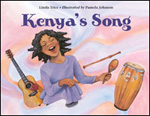 In this follow-up book to Kenya’s Word (2006) Kenya is faced with a homework assignment to identify and bring her favorite song to school to share with her class. Kenya’s mother and sister suggest their favorite song and her father plays other possibilities on the piano, but none of these are quite right. The next day Kenya accompanies her father to the Caribbean Cultural Center where she experiences music from Cuba, Trinidad, the Dominican Republic, and Puerto Rico. On her walk home with her father, listening to the variety of sounds around her, Kenya is inspired to create, with her father’s help, her favorite song:
In this follow-up book to Kenya’s Word (2006) Kenya is faced with a homework assignment to identify and bring her favorite song to school to share with her class. Kenya’s mother and sister suggest their favorite song and her father plays other possibilities on the piano, but none of these are quite right. The next day Kenya accompanies her father to the Caribbean Cultural Center where she experiences music from Cuba, Trinidad, the Dominican Republic, and Puerto Rico. On her walk home with her father, listening to the variety of sounds around her, Kenya is inspired to create, with her father’s help, her favorite song:
English, French, Spanish, too —
Music’s how I speak to you!
Doesn’t matter where you’re from —
Just sing your song and play your drum!
Kenya’s Song is a heart-warming story that celebrates the diverse music found in different cultures.
- Prisca Martens, Towson University, Towson, Maryland
Tullet, Herve. (2013). I am Blop! New York: Phaidon Press.
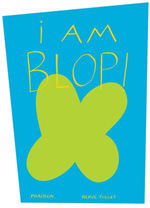 This light-hearted, fun book is the latest imaginative creation from French artist Herve Tullet, author/illustrator of Press Here (2011). Blop is a shape, similar to a butterfuly or flower, that comes in a wide variety of colors, sizes, and textures. In addition to the diversity possibilities for appearance, Blops do a range of things, including grow and learn, and they live in such places as families, the sky, museums, the countryside, and cities. This book will have readers discovering Blops around them and imagining what else Blops can be and do. The book itself is an odd rectangular-type shape which adds to the creativity the book inspires. The final pages of the book include Blops that can be punched-out and a series of questions not in the book, such as “What do Blops eat?”, to spark readers imaginations.
This light-hearted, fun book is the latest imaginative creation from French artist Herve Tullet, author/illustrator of Press Here (2011). Blop is a shape, similar to a butterfuly or flower, that comes in a wide variety of colors, sizes, and textures. In addition to the diversity possibilities for appearance, Blops do a range of things, including grow and learn, and they live in such places as families, the sky, museums, the countryside, and cities. This book will have readers discovering Blops around them and imagining what else Blops can be and do. The book itself is an odd rectangular-type shape which adds to the creativity the book inspires. The final pages of the book include Blops that can be punched-out and a series of questions not in the book, such as “What do Blops eat?”, to spark readers imaginations.
- Prisca Martens, Towson University, Towson, Maryland
Verde, Susan. (2013). The museum. Illus. by Peter Reynolds. New York: Abrams Books for Young Readers.
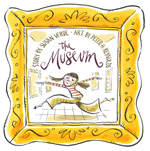 In this delightful book readers visit an art museum with a young girl who describes what she sees and how she feels. The text begins with “When I see a work of art, something happens in my heart” and with that the girl whirls and twirls through the museum galleries. As she views the various works, her feelings and emotions in response range from sadness to hunger to joy to fear to happiness. The girl stops short, though, when she comes upon a large blank canvas and wonders what it means. When she realizes the canvas is hers to fill, she is overjoyed and leaves the museum knowing, “[The museum’s] rhythm exists in all I see. The museum lives inside of me.” Reynold’s pen-and-ink drawings with some color added bring Verde’s rhymed text to life. The front end-papers show Reynold’s renderings of various works of art and the back end-papers are blank canvases to inspire readers’ creativity.
In this delightful book readers visit an art museum with a young girl who describes what she sees and how she feels. The text begins with “When I see a work of art, something happens in my heart” and with that the girl whirls and twirls through the museum galleries. As she views the various works, her feelings and emotions in response range from sadness to hunger to joy to fear to happiness. The girl stops short, though, when she comes upon a large blank canvas and wonders what it means. When she realizes the canvas is hers to fill, she is overjoyed and leaves the museum knowing, “[The museum’s] rhythm exists in all I see. The museum lives inside of me.” Reynold’s pen-and-ink drawings with some color added bring Verde’s rhymed text to life. The front end-papers show Reynold’s renderings of various works of art and the back end-papers are blank canvases to inspire readers’ creativity.
- Prisca Martens, Towson University, Towson, Maryland
GRADES 4-6
Bryant, Jen. (2013). A splash of red: The life and art of Horace Pippin. Illus. by Melissa Sweet. New York: Knopf Books.
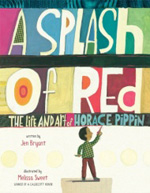 A Splash of Red documents the life and art of Horace Pippin (1888-1946), a self-taught African-American artist who “couldn’t stop drawing.” Jen Bryant beautifully tells Pippin’s story, including his passion for art that began at a young age, how he won his first set of art supplies through a magazine drawing contest, and how he quit school in eighth grade to work when his father left his family. She also shares how an injury while Pippin served in the Army during World War I threatened to end his ability to draw, but he found a way to continue his art. A United States map on the back end-papers indicates the major museums displaying Pippin’s work. Melissa Sweet’s mixed-media illustrations are stunning and include quotes that bring Pippin’s own voice into the telling of his story. The back matter also includes additional biographical information on Pippin and author and illustrator notes.
A Splash of Red documents the life and art of Horace Pippin (1888-1946), a self-taught African-American artist who “couldn’t stop drawing.” Jen Bryant beautifully tells Pippin’s story, including his passion for art that began at a young age, how he won his first set of art supplies through a magazine drawing contest, and how he quit school in eighth grade to work when his father left his family. She also shares how an injury while Pippin served in the Army during World War I threatened to end his ability to draw, but he found a way to continue his art. A United States map on the back end-papers indicates the major museums displaying Pippin’s work. Melissa Sweet’s mixed-media illustrations are stunning and include quotes that bring Pippin’s own voice into the telling of his story. The back matter also includes additional biographical information on Pippin and author and illustrator notes.
- Prisca Martens, Towson University, Towson, Maryland
Ko, Alex. (2013). Alex Ko: From Iowa to Broadway, my Billy Elliot story. New York: Harper Collins.
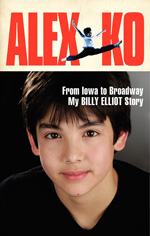 In this inspiring autobiography Alex Ko details his life from his early years in Iowa to his starring role in Billy Elliot: The Musical on Broadway in New York. Ko describes his passion for gymnastics and dance/ballet even as a young child and how, with the support of his family, he was able to take lessons and enter competitions. His father’s death devastated Ko, but he worked through his sorrow and pain and later financial difficulties. At age 13, he got to Broadway and became the first replacement for one of the original the actors playing the role of Billy. Ko describes the pressures he faced, including practices and classes, but the joy and excitement he ultimately experienced with his first Broadway performance. Throughout the book Ko highlights the love and dedication of his family and emphasizes their critical role in his success. Ko’s commitment, strong faith, captivating personality come through clearly in the book, making this a compelling read. A photo album at the end of the book provides pictures of Ko and his family during his growing-up years.
In this inspiring autobiography Alex Ko details his life from his early years in Iowa to his starring role in Billy Elliot: The Musical on Broadway in New York. Ko describes his passion for gymnastics and dance/ballet even as a young child and how, with the support of his family, he was able to take lessons and enter competitions. His father’s death devastated Ko, but he worked through his sorrow and pain and later financial difficulties. At age 13, he got to Broadway and became the first replacement for one of the original the actors playing the role of Billy. Ko describes the pressures he faced, including practices and classes, but the joy and excitement he ultimately experienced with his first Broadway performance. Throughout the book Ko highlights the love and dedication of his family and emphasizes their critical role in his success. Ko’s commitment, strong faith, captivating personality come through clearly in the book, making this a compelling read. A photo album at the end of the book provides pictures of Ko and his family during his growing-up years.
- Prisca Martens, Towson University, Towson, Maryland
Maddox, Jake, & McDonald, Leigh. (2013). Dance team dilemma. Illus. by Katie Wood. North Mankato, MN: Stone Arch Books.
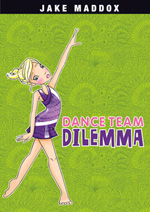 Hannah and Caitlin are excited to audition for the junior high dance squad, and they immediately begin practicing routines for their try-outs. Caitlin catches on easily while Hannah struggles to keep up, but they both make the team. After the first practice Hannah is concerned that she’s not as good as the other dancers and decides to have extra practices at home to improve her skills. Caitlin, however, wants to do other things, like go to the movies and the mall and spend time with Connor, the boy she likes. When Hannah has to choose between going with Caitlin to Connor’s house and practicing for her try-out for a solo, she decides to stay home and practice. Hannah lands one of the solos, and Caitlin doesn’t. Their friendship is strained at first, but in the end Hannah is excited to have her friend back and to dance a solo in the upcoming dance competition. This charming story focuses on balancing friendships and ambition and on the rewards of determination and hard work. The back matter includes a glossary, discussion questions, writing prompts, and information on different forms of dance.
Hannah and Caitlin are excited to audition for the junior high dance squad, and they immediately begin practicing routines for their try-outs. Caitlin catches on easily while Hannah struggles to keep up, but they both make the team. After the first practice Hannah is concerned that she’s not as good as the other dancers and decides to have extra practices at home to improve her skills. Caitlin, however, wants to do other things, like go to the movies and the mall and spend time with Connor, the boy she likes. When Hannah has to choose between going with Caitlin to Connor’s house and practicing for her try-out for a solo, she decides to stay home and practice. Hannah lands one of the solos, and Caitlin doesn’t. Their friendship is strained at first, but in the end Hannah is excited to have her friend back and to dance a solo in the upcoming dance competition. This charming story focuses on balancing friendships and ambition and on the rewards of determination and hard work. The back matter includes a glossary, discussion questions, writing prompts, and information on different forms of dance.
- Prisca Martens, Towson University, Towson, Maryland
GRADES 7-12
Beram, Nell, & Boriss-Krimsky, Carolyn. (2013). Yoko Ono: Collector of Skies by New York: Amulet Books.
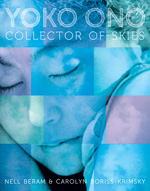 Written in honor of Yoko Ono’s 80th birthday, this thoughtful biography chronicles her complex life from her birth to today. The chapters describe Ono’s privileged but troubled life as the child of wealthy parents in Japan, her fear and struggles during World War II, her marriage against her parents’ wishes, her difficult life in New York, her third marriage to John Lennon, her children, and her activities and exhibitions after Lennon’s death. Ono is portrayed as a creative, intelligent, strong-willed, independent woman whose unique forms of visual art, writing, music, and performance works have contributed much to our cultural history. Rich with photographs of Ono’s family and art and interesting details, the book offers an intriguing glimpse into the life of a well-known artist. A timeline of Ono’s life, detailed bibliography, and index are included in the back matter.
Written in honor of Yoko Ono’s 80th birthday, this thoughtful biography chronicles her complex life from her birth to today. The chapters describe Ono’s privileged but troubled life as the child of wealthy parents in Japan, her fear and struggles during World War II, her marriage against her parents’ wishes, her difficult life in New York, her third marriage to John Lennon, her children, and her activities and exhibitions after Lennon’s death. Ono is portrayed as a creative, intelligent, strong-willed, independent woman whose unique forms of visual art, writing, music, and performance works have contributed much to our cultural history. Rich with photographs of Ono’s family and art and interesting details, the book offers an intriguing glimpse into the life of a well-known artist. A timeline of Ono’s life, detailed bibliography, and index are included in the back matter.
- Prisca Martens, Towson University, Towson, Maryland
These reviews are submitted by members of the International Reading Association's Children's Literature and Reading Special Interest Group (CL/R SIG) and are published weekly on Reading Today Online. The International Reading Association partners with the National Council of Teachers of English and Verizon Thinkfinity to produce ReadWriteThink.org, a website devoted to providing literacy instruction and interactive resources for grades K–12.